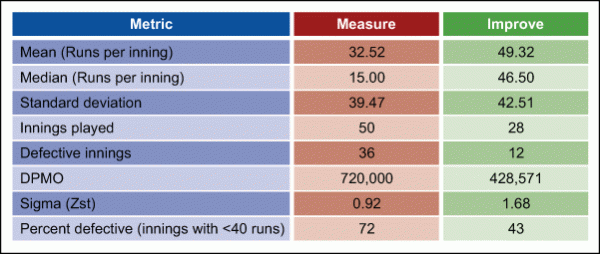
Cricket: Description and Glossary
Cricket is one of the world’s most popular games. It is played between two teams of 11 players. In a one-day cricket game, each team is allowed to bat for a maximum of 50 overs and the team scoring more runs is declared the winner. Each team has a combination of batsmen (players who score the runs), bowlers (players who deliver the ball to the batsmen from the opposing team) and a wicket-keeper.
Batting average: Total number of runs scored by a batsman divided by the number of times he has been dismissed.
Bowled: One of the ways in which a batsman can be dismissed; the batsman is dismissed when the ball hits the wickets while he attempts to play the ball.
Bowler: Player who delivers ball to opposing team’s batsmen; may be right- or left-armed.
Caught behind: A catch taken by the wicket-keeper or the fielders in the slip (standing behind the batting wicket) that results in the dismissal of the batsman.
Caught (outfield): A catch taken by a fielder (other than the wicket-keeper, fielders in the slip and the bowler himself) that results in the dismissal of the batsman.
Crease: The batting zone.
Dismissal: When a batsman is dismissed, he cannot continue batting any further in the same inning.
Inning: Each team’s turn to bat or bowl is called one inning. In a one-day game, each inning consists of a maximum 50 overs where one team bats while the other bowls.
Keeper (wicket-keeper): Fielder standing behind the batsman to catch or stop the ball.
LBW (leg before wicket): The batsman is adjudged out if he is hit by the ball before taking his shot.
Over: Six legal deliveries by a bowler makes one over.
Pitch: The main strip of playing area, often short grass.
Run out: The batsman is adjudged out when a member of the fielding team hits the wickets with the ball when the batsman is outside the crease while attempting to take a run.
Seam bowler: A bowler who usually bowls fast (speed of 120 kilometers per hour or more).
Slip fielder: See keeper.
Spinner: Slow bowlers who spin the ball using their wrist or fingers.
Stance: Posture of the batsman while batting on the cricket pitch. A batsman usually uses a closed stance (the front shoulder pointing toward the bowler while batting) or an open stance (the batsman standing at a slightly wider angle compared to the closed stance).
Strike rate: Number of runs scored by a batsman per 100 deliveries.
Stump: Wicket used.
Mike was the best batsman in the Club Acme cricket team. The probability of Club Acme’s winning a match was higher when he batted well and scored more runs. His batting form had been declining the past few months, however, affecting the team’s win percentage and revenues. Improving Mike’s consistency with the bat would help the team win more matches. The team hired a Lean Six Sigma Black Belt to analyze the factors affecting Mike’s batting and develop an improvement plan. A project team was formed with the chief batting coach as the project leader.
Problem Statement
The average number of runs scored by Mike per inning was 32.5 for the last 50 matches (January 2011 to December 2011) compared to his benchmarked 40 runs per inning. This lowered number of runs negatively affected Club Acme’s match results; the team won only 36 percent of the matches they played in the same timeframe. (See Figure 1.)
Process Capability
Forty runs in a completed inning was the benchmark and set as the lower specification limit (LSL) for assessing process capability. Any complete innings in which Mike scored fewer than 40 runs was considered a defect. Mike played 50 matches in 2011 and as he usually batted at the top of the batting order, he was dismissed in all 50 matches. He scored more than 40 runs in only 14 out of 50 innings.

| Table 1: Batting Statistics for Mike in 2011 | |
| Innings played (N) |
50 |
| Defects (< |
36 |
| Mean |
32.52 |
| Median |
15 |
| Standard deviation |
39.47 |
| DPMO (defects per million opportunities) |
720,000 |
| Sigma (Zst) |
0.92 |
The project team determined the improvement target by using the 1-sample percent-defective test (Figure 2).

The 1-sample percent-defective test compared Mike’s current defective rate to a target of 50 percent. With a 0.05 level of significance and a calculated p-value of 0.001, the test verified statistically that Mike’s current percent defective was greater than 50 percent. At a 90 percent confidence level, the true percent defective was between 59.74 percent and 82.21 percent. (The confidence interval (CI) quantifies the uncertainty associated with estimating the percent defective from the sample data.) The team concluded that if Mike scored 40 runs or more in 50 percent the matches played, it would be a statistically significant improvement.
Root Cause Analysis of Batting Performance
The team analyzed data for all of the innings in which Mike scored fewer than 40 runs. In 30 out of 36 defective innings (83 percent), Mike was dismissed for fewer than 20 runs. Once Mike crossed 20 runs, the probability of playing a longer inning was high – he was dismissed only 6 times between 20 and 40 runs out of the overall 50 completed innings. Why was Mike dismissed so often before scoring 20 runs?
The team used a Pareto chart to identify the dismissal types when:
- Mike scored fewer than 20 runs
- Mike scored more than 20 runs
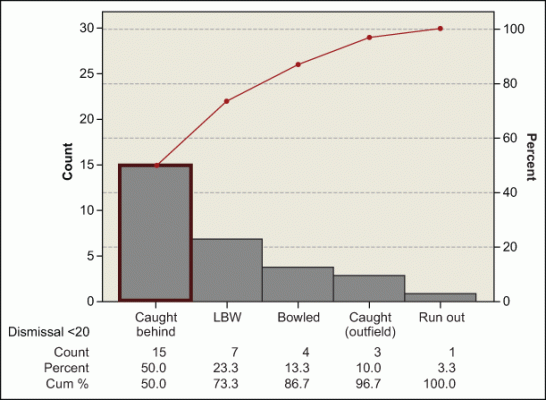
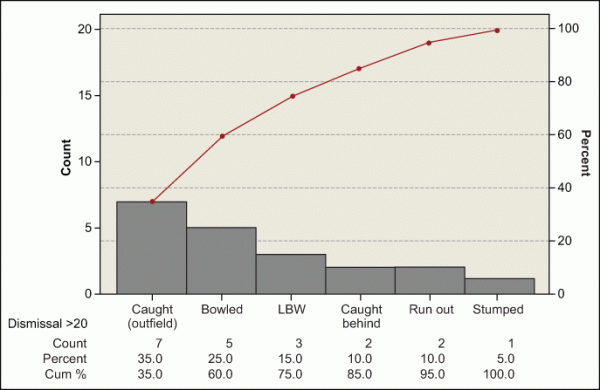
Being caught behind was the most frequent cause for dismissal when Mike scored fewer than 20 runs: 50 percent compared to 10 percent when he scored more than 20 runs. Why was Mike getting caught by the keeper and the slip fielders so often at the start of his innings? Club Acme’s statistician provided the shot data for Mike as shown in Figure 5.
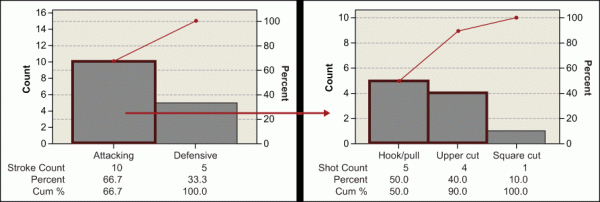
Of Mike’s caught behind dismissals at the start of his innings, 67 percent occurred while he was playing attacking strokes. In particular, the attacking shots (a subset of attack strokes) that contributed most often to the caught behind dismissals were three types of high-risk shots: hooks, pulls and upper cuts.
A Closer Look at the Shots
The team analyzed the success of these shots played by Mike at the start of his innings and later in the games. By looking at Mike’s historical strike rate, it was clear that he used to play 25 balls to score 20 runs. The team tested the success of his hook, pull and upper cut shots during the first 25 balls played by Mike in comparison to shots played after 25 balls. The strike rate for balls 26 and higher was almost double compared to the first 25 balls. Compared to 10 dismissals out of 28 attempts in the first 25 balls, Mike was dismissed just 4 times in 117 attempts after playing 25 balls.
| Table 2: Shot Analysis for Mike | ||
| Statistics | 0-25 Balls | 26+ Balls |
| Total shots played |
28 |
117 |
| Number of dismissals |
10 |
4 |
| % defective |
35.71% |
3.42% |
| 90% CI |
(21 – 53)% |
(1 – 8)% |
| p-value |
0.000 |
|
| Balls per dismissal |
2.80 |
29.25 |
The conclusion from this analysis was that Mike had to avoid playing those higher-risk shots in the initial stages of his innings.
Other Inputs for Batting
In a brainstorming session, the project team identified the various factors related to runs being scored and created the cause-and-effect diagram shown in Figure 6. Items highlighted in red are the ones deemed to be most critical and that were investigated further.
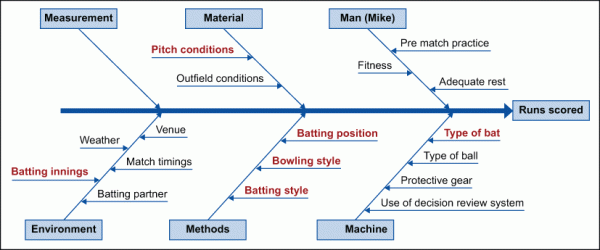
The project team did not find any difference in Mike’s performance when batting first or when chasing a target. His performance on flat pitches, however, was better compared to green pitches. What was affecting Mike’s batting while playing on green pitches? The batting coach suggested the team look at the type of bat Mike used and his batting position. While the type of bat used (light or heavy) did not have any measurable impact, Mike performed better on green pitches when he was not required to open the batting (bat first) and face the new ball bowlers. On green pitches, his batting average in fourth position was 52.6 compared to 12.1 when Mike opened the batting, a statistically significant difference (Figure 7).
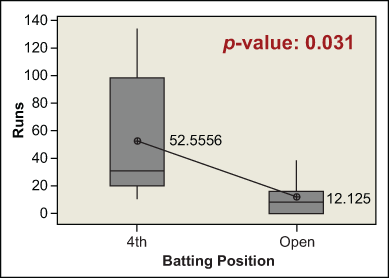
The project team collected data for Mike’s batting and shot selection against different types of bowlers. Shots played by Mike that did result, or could have resulted, in a dismissal were identified as false or risky and termed “defective.” The proportion of defective shots was contrasted against the total number of balls played against each type of bowler.
As shown in Table 3 and Figure 8, there were differences among the percent defectives for different bowling types at a 0.05 level of significance (p-value: 0.000). From the analysis, it was concluded that Mike played more false or risky shots while playing left-arm seam bowlers (21.48 percent) in comparison to other bowlers such as right-arm seam bowlers and spinners.
| Table 3: Bowling Style Effects on Mike | ||||
|
Bowling Style |
Balls Played |
Defective Shots |
% Defective |
95% CI |
|
Right-arm seam |
793 |
65 |
8.20 |
(6.38, 10.33) |
|
Left-arm seam |
298 |
64 |
21.48 |
(16.95, 26.58) |
|
Leg spin |
257 |
31 |
12.06 |
(8.34, 16.68) |
|
Off spin |
436 |
33 |
7.57 |
(5.27, 10.47) |
|
Left-arm spin |
199 |
26 |
13.07 |
(8.72, 18.56) |
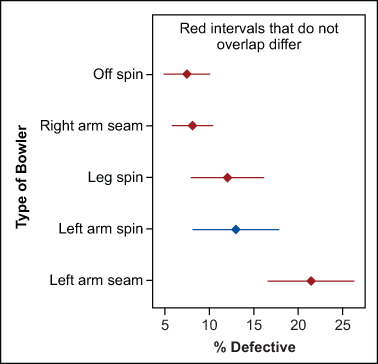
The chief batting coach analyzed video footage of Mike batting against left-arm seam bowlers. Mike played a left-arm seam with a closed stance, similar to what he used for right-arm seam bowlers. The orthodox stance blocked him before he played a shot, and he ended up playing around his front pad (protective clothing). He also kept his backswing too straight, playing across the line (moving laterally to the incoming ball) and ended up chest-on to the ball.
Mike was advised to play left-arm seam with an open stance and wider back-lift. With an open stance, he could better align himself up to the incoming ball. For a wider back-lift, he had to pick his bat over the off stump or the first slip area (angle of the bat while playing the ball changes depending upon the starting position of the bat) rather than over the middle stump.
The Improvement Plan
After the analysis was complete, the project team summarized its results and made its improvement recommendations for Mike and Club Acme.
| Table 4: Action Plan | |||
| Root Cause |
Description |
Improvement |
Responsibility |
| Batting Style | Hooks, pulls and upper cuts were contributing to the maximum number of dismissals at the start of Mike’s innings. | Mike needs to avoid playing these high-risk shots in the initial stages of his innings (the first 20 to 25 balls). | Mike, batting coach, team captain |
| Pitch Conditions | Mike’s batting average on green pitches is significantly lower compared to his performance on flat pitches. The problem is facing the new ball at the start of his innings on green pitches that suit seam bowling. He does well batting lower down in the order on green pitches. | Mike should be placed in fourth position in matches played on green pitches.Continuously changing the batting order based on pitch conditions would negatively impact other players. As Mike’s batting is consistent at all positions on flat pitches, Mike would bat at fourth position in all matches irrespective of pitch conditions. | Team captain, batting coach |
| Bowling Style | Mike tends to play more false or risky shots while facing left-arm seam bowlers. | Mike needs to play left-arm seam bowlers with an open stance and wider back-lift. There would be mandatory left-arm net bowlers at team practice sessions. | Mike, batting coach, team manager |
Project Outcome and Benefits
The action plan recommended by the Black Belt and the project team helped improve Mike’s batting consistency. He scored an average of 49.32 runs per inning in the 28 innings of the first six months of 2012 compared to his previous baseline average of 32.52 runs per inning, as shown in Figure 9. In addition, Club Acme improved its win rate to 54 percent (16 out of 28).
